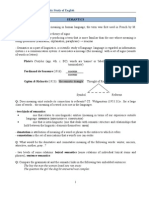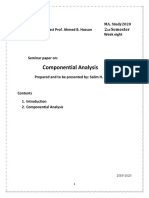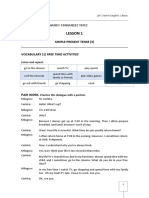Componential Analysis and Examples
Uploaded by
Mar CrespoComponential Analysis and Examples
Uploaded by
Mar CrespoComponential analysis
Words are not the smallest semantic units but are built up (made)
of smaller components of meaning which are combined differently
(or lexicalized) to form different words.
Thus, words like woman, bachelor, spinster, and wife have been
viewed as being composed of elements such as [ADULT], [HUMAN]
and so on:
woman [FEMALE] [ADULT] [HUMAN]
bachelor [MALE] [ADULT] [HUMAN] [UNMARRIED]
spinster [FEMALE] [ADULT] [HUMAN] [UNMARRIED]
wife [FEMALE] [ADULT] [HUMAN] [MARRIED]
The elements in square brackets are called semantic components, or
semantic primitives, and this kind of analysis is often called
componential analysis (CA for short)
What is a semantic component?
A semantic component is a potentially contrastive part of the
meaning of a lexical unit. It distinguishes one lexical unit from
another, e.g., “Male” is the contrastive semantic component
distinguishing man from woman, and boy from girl.
What is a lexical unit?
A lexical unit is a form-meaning composite that represents a lexical
form and the single meaning of a lexeme.
1. The componential analysis of sparrow is the following one:
a) [+beak] [+feathers] [+small and lightweight] [-can fly] [+thin/short legs] [+short tail]
b) [+beak] [-feathers] [+small and lightweight] [+can fly] [+thin/short legs] [+short tail]
c) [+beak] [+feathers] [+small and lightweight] [+can fly] [+thin/short legs] [+short tail]
d) [+beak] [+feathers] [-small and lightweight] [-can fly] [-thin/short legs] [+short tail]
2. The description [+beak] [+feathers] [+thin/short legs] [+short tail] [-red breast] corresponds to the
componential analysis of:
a) dove
b) ostrich
c) bird
d) stork
3. The componential analysis of ‘colt’ is:
a) [+equine] [+male] [+mature]
b) [+equine] [-male] [+mature]
c) [+equine] [-male] [-mature]
d) [+equine] [+male] [-mature]
4. The componential analysis of ‘filly’ is:
a) [+equine] [+male] [+mature]
b) [+equine] [-male] [+mature]
c) [+equine] [-male] [-mature]
d) [+equine] [+male] [-mature]
5. The following definition in terms of componential analysis (Lays eggs [+], beak [+], two wings and two legs
[+], feathers [+], small and lightweight [+], can fly [+], chirps/sings [+], thin/short legs [+], short tail [+], red
breast [+]) corresponds to the word:
a) sparrow
b) robin
c) dove
d) ostrich
6. The componential analysis of ‘spinster’ is:
a. [+FEMALE] [+ADULT] [+HUMAN]
b. [−FEMALE] [+ADULT] [+HUMAN] [−MARRIED]
c. [+FEMALE] [+ADULT] [+HUMAN] [−MARRIED]
d. [+FEMALE] [+ADULT] [+HUMAN] [+MARRIED]
7. The componential analysis of ‘wife’ is:
a. [+FEMALE] [+ADULT] [+HUMAN]
b. [−FEMALE] [+ADULT] [+HUMAN] [−MARRIED]
c. [+FEMALE] [+ADULT] [+HUMAN] [−MARRIED]
d. [+FEMALE] [+ADULT] [+HUMAN] [+MARRIED]
8. The componential analysis of ‘bachelor’ is:
a. [+FEMALE] [+ADULT] [+HUMAN]
b. [−FEMALE] [+ADULT] [+HUMAN] [−MARRIED]
c. [+FEMALE] [+ADULT] [+HUMAN] [−MARRIED]
d. [+FEMALE] [+ADULT] [+HUMAN] [+MARRIED]
9. The componential analysis of ‘boy’ is:
a. +HUMAN +ADULT +MALE
b. +HUMAN +ADULT -MALE
c. +HUMAN -ADULT +MALE
d. +HUMAN -ADULT -MALE
You might also like
- Genki 1 - Workbook: An Integrated Course in Elementary Japanese 194% (62)Genki 1 - Workbook: An Integrated Course in Elementary Japanese 1139 pages
- Componential Analysis: Ivana Grbavac, Assist. Prof. University of MostarNo ratings yetComponential Analysis: Ivana Grbavac, Assist. Prof. University of Mostar20 pages
- Câu 1.what Are Lexical Meaning and Grammatical Meaning?No ratings yetCâu 1.what Are Lexical Meaning and Grammatical Meaning?42 pages
- Presupposition and Entailment by DR - Shadia100% (2)Presupposition and Entailment by DR - Shadia31 pages
- (With Notes) Presupposition and Entailment100% (1)(With Notes) Presupposition and Entailment32 pages
- The Distinction Between Lexical and Grammatical Expressions100% (2)The Distinction Between Lexical and Grammatical Expressions5 pages
- Q-The Levels of Meaning. 1-Expression Meaning 2 - Utterance Meaning 3 - Communicative Meaning100% (1)Q-The Levels of Meaning. 1-Expression Meaning 2 - Utterance Meaning 3 - Communicative Meaning9 pages
- Lexical Relations Types - Examples - MCQsNo ratings yetLexical Relations Types - Examples - MCQs4 pages
- Lecture 2 - Fundamental Language AbilitiesNo ratings yetLecture 2 - Fundamental Language Abilities11 pages
- Linguistics II - Presupositions, Entailments and Implicatures100% (1)Linguistics II - Presupositions, Entailments and Implicatures6 pages
- Discourse Analysis - Topic & The Representation of Discourse Content (Unpublished)No ratings yetDiscourse Analysis - Topic & The Representation of Discourse Content (Unpublished)13 pages
- The Differences of Discourse Analysis and PragmaticsNo ratings yetThe Differences of Discourse Analysis and Pragmatics8 pages
- What Are The Different Types of Antonyms in EnglishNo ratings yetWhat Are The Different Types of Antonyms in English2 pages
- M.a.K. Halliday and Systemic-Functional Linguistics80% (5)M.a.K. Halliday and Systemic-Functional Linguistics2 pages
- Participant Roles Exercises and ExamplesNo ratings yetParticipant Roles Exercises and Examples4 pages
- Reference, Denotion and Sense Theory and PracticeNo ratings yetReference, Denotion and Sense Theory and Practice3 pages
- The Writing Process and Creative Writing PDFNo ratings yetThe Writing Process and Creative Writing PDF67 pages
- Written Assignment: Kindly Bear in Mind That The Assignment Is Not Necessarily A Didactic UnitNo ratings yetWritten Assignment: Kindly Bear in Mind That The Assignment Is Not Necessarily A Didactic Unit1 page
- English Language: Top 40 Most Important Error Detection Questions of Adverb (Solution)No ratings yetEnglish Language: Top 40 Most Important Error Detection Questions of Adverb (Solution)2 pages
- Nowadays Celebrities Earn More Money Than PoliticiansNo ratings yetNowadays Celebrities Earn More Money Than Politicians5 pages
- Unit 12 Vocabulary Colloquial Words/phrases:: BucksNo ratings yetUnit 12 Vocabulary Colloquial Words/phrases:: Bucks6 pages
- Class 9 - IT - Unit - 1 Communication Skills - I - IMP. NOTESNo ratings yetClass 9 - IT - Unit - 1 Communication Skills - I - IMP. NOTES20 pages
- English Meaning Proposition: Prepositions, Heavily Used Topic in Quran (Seq # 15)No ratings yetEnglish Meaning Proposition: Prepositions, Heavily Used Topic in Quran (Seq # 15)8 pages
- Revision Notes - Bahasa Inggris 1 - Kelas 1 - Chapter 5 My AbilityNo ratings yetRevision Notes - Bahasa Inggris 1 - Kelas 1 - Chapter 5 My Ability6 pages
- Grading Rubric For A Research Paper-Any Discipline: Introduction/ ThesisNo ratings yetGrading Rubric For A Research Paper-Any Discipline: Introduction/ Thesis2 pages











































































































